|
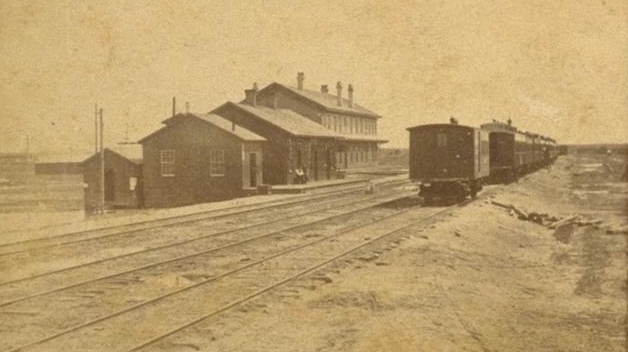
Cheyenne Depot, June 1869, photo by William Henry Jackson
Cheyenne was desginated as the winter headquarters for railroad crews extending the line westward.
As observed on the preceeding page, Cheyenne was at first a motley collection of tents and temporary or hastily constructed
wooden buildings. Bancroft explained:
Six thousand people wintered in Cheyenne, the accommodations for the shelter of a large part of them being tents and sod
houses, or "dug-outs." A canvas saloon would answer as well as another for gambling,
drinking, and the practices of the dives.
In 1868, Congress
created Wyoming out of portions of Dakota, Utah and Idaho Territories. The Territorrial Government was
organized in 1869.
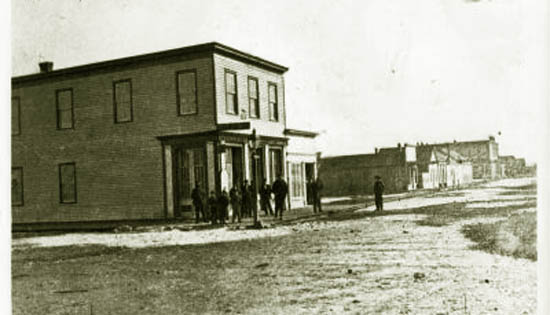
Legislative Hall, 1869
Two rooms in the Hall were rented. Additional space was rented for House.
But as the capital city, Cheyenne was typical of
some other territorial capitals. Mark Twain in Roughing It described the seat of government in
Nevada, furnished rent free by an individual known as "Old Abe Curry":
He also furnished pine benches and chairs for the legislature, and covered the
floors with clean saw-dust by way of carpet and spittoon combined. But for
Curry the government would have died in its tender infancy. A canvas partitition to
separate the Senate from the House of Representatives was put by the
Secretary, at a cost of three dollars and forty cents, but the United States
declined to pay for it. Upon being reminded that the "instructions" permitted the
payment of a liberal rent for a legislative hall, and that money was saved to
the country by Mr. Curry's generosity, the United States said that did not alter
the matter, and the three dollars and forty cents would be subtracted from the
Secretary's eighteen hundred dollar salary -- and it was!
In Cheyenne the governmental quarters were hardly better; as described by Professor T. A. Larson:
Since there was no capitol building, two rooms were rented in buildings about one and one-half blocks
apart on Sixteenth and Seventeenth streets for use by the two houses of the
legislature. The Council chamber was within half a block, and the House
chamber within a block and a half, of Luke Murrin's wholesale liquor house, which had
a convenient sample room in the back."
Quarters for the governmental officials were not provided. Thus, the Territorial Secretary, Edward M. Lee,
took to the practice of law and Governor Campbell took to raising funds for the
construction of a church. In contrast, however, Carson City, at least provided a
gubernatorial mansion, something which Wyoming did not do until 1905. In some instances where
a gubernatorial mansion was provided, it was less than ostentatious. In Arizona Territory, the governor was provided
with a two-room rough hewn log cabin. The
Nevada mansion was described by Twain:
We found the state palace of the governor of Nevada territory to consist of a white frame
one-story house with two small rooms in it and a stanchion supported shed in front -- for
grandeur -- it compelled the respect of the citizen and inspired the
Indians with awe. The newly arrived Chief and Associate Justices of the
Territory, and other machinery of the government, were domiciled with
less splendor. They were boarding around privately, and had their offices in their
bedrooms.
The Secretary and I took quarters in the "ranch" of a worthy French lady by the
name of Bridget O'Flannigan, a camp follower of his Excellency the Governor.
She had known him in his prosperity as commander-in-chief of the Metropolitan Police of
New York, and she would not desert him in his adversity as Governor of Nevada.
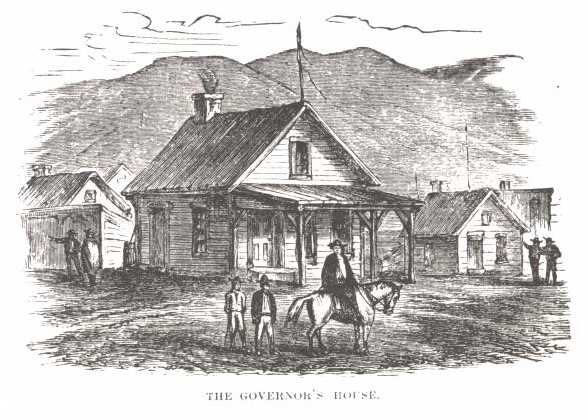
Nevada Governor's "Mansion," 1862, see text.
In 1869, Albert D. Richardson, a correspondent for the New York Tribune, described
Cheyenne:
Cheyenne is the capital of Wyoming, the desert city of a desert State. It is watered by Crow Creek,
a little stream which feeds the Lodge Pole, and then the Platte. It boasts
a great locomotive-house of sand-stone; stone machine-shops just rising for
the Railway Company; a long, porticoed frame hotel [view below], also belonging to the
Union Pacific, which will dine four hundred people and lodge fifty; a few
large warehouses; three or four blocks of low, flat-roofed wooden shops,
full of goods; mainly scattering tents and shanties; two daily newspapers;
two churches; a score or two of drinking, gambling, and dance-houses, which
are crowded after dark; and a population of five thousand.
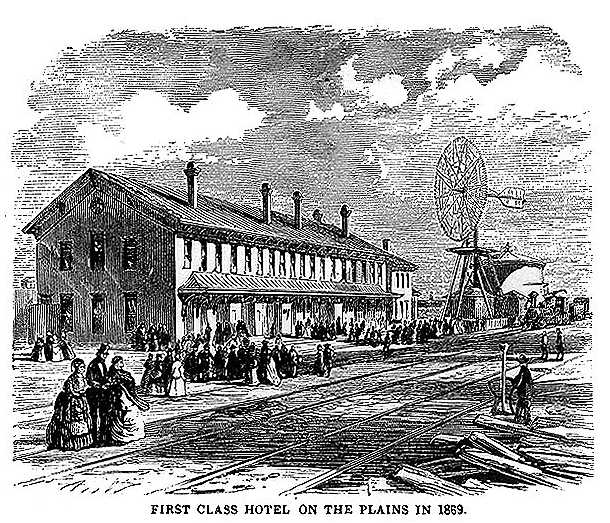
Union Pacific Hotel, Cheyenne, 1869, woodcut
Richardson continued in his description:
For a wonder, it has neither an Opera House, nor an Academy of Music!
But I find instead the enormous tent of a traveling circus from the
"States." In the evening, it is crowded with twelve hundred people,
all eager for the "great moral spectacle," which some have come forty
miles on the railway to enjoy. There sat the tanned youth, eating molasses
candy, with their "girls," the boys yelling with delight at the little mule,
and everybody applauding the clowns’ time-honored jokes, in the good,
old-fashioned country way.
Cheyenne is woefully destitute of a "back country." It borrows leave to be
from the Denver trade, the railway machine-shops, and the new Sweetwater
gold mines, which, though two or three hundred miles to the north-west,
buy most of their supplies here. Lumber costs from $60 to $100 per 1,000;
wood, $8.75 per cord, and milk, twenty cents a quart. A few ranches are
opening; but Wyoming boasts of very little soil which promises to reward
the farmer less than any other State or Territory. By way of compensation,
though, it has gold mines which are opening well, and some of the richest
coal fields in the world. The whole of it, too, is excellent grazing range;
the beef at the Cheyenne Hotel, wintered upon those mountain deserts, is
as rich and tender as I ever tasted at Delmonico's. Richardson, Abby Sage:
Garnered Sheaves from the Writings of Albert D. Richardson, Columbia Book Company, Hartford, 1871, p. 281.
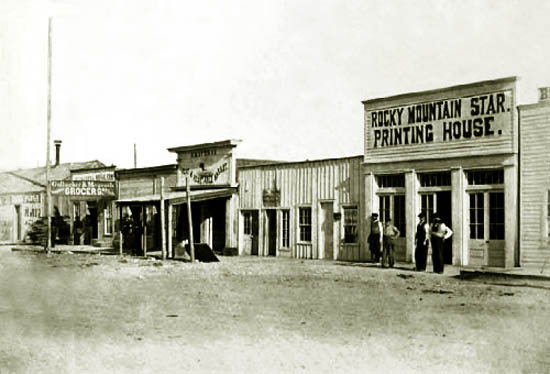
Rocky Mountain Star Pinting House, approx. 1869.
By the
end of 1868, the City had three newspapers, the Evening Leader published by N. A. Baker,
the Daily Argus published by L. L. Bedell, and
the Rocky Mountain Star published by O. T. Williams, and three banks. The Star was edited by James W. Hayford. Within a year it sold out to
the Leader. Hayford moved to Laramie City where he published the Laramie Sentinel on a used
printing press hauled from South Pass City.
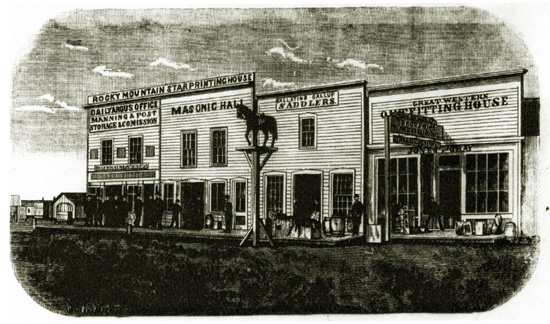
Northside of 17th Street, 1868
Left to Right from the intersection with Ferguson (present-day Carey): the
Rocky Mountain Steam Printing House in which both the Rocky Mountain Star and the Daily Argus
were published; the Masonic Hall, Gallatin & Galllup's Saddlery and the Rocky Mountain Outfitting House.
Both the Argus and the Star were basicly devoid of news and consisted of mostly advertising. Some of the advertising in
the Star might seem a little odd today. The Star had advertisments for the "Cottage of content Saloon" and
Cheyenne Lodge No. 16, Free and Accepted Masons was chartered on October 7 1868, by the Grand Lodge of
Colorado. Upon the formation of the Grand Lodge of Wyoming in 1874, it was renumbered as
Cheyenne Lodge No. 1.
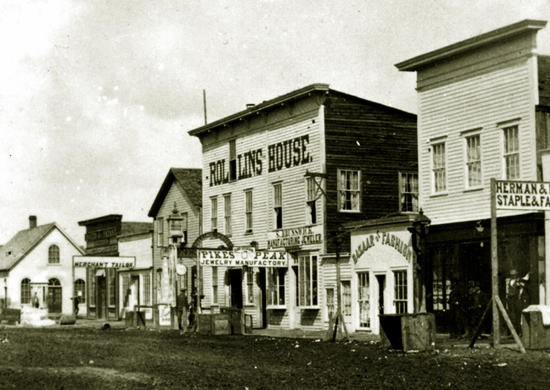
Rollins House hotel, approx. 1868.
Next page, Cheyenne Photos continued, early impressions of Cheyenne..
|